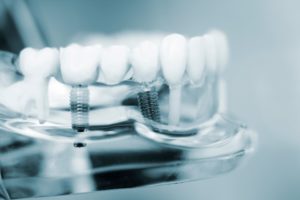February 5, 2024

In our contemporary culture, dental implants are considered by many to be the ideal method to replace missing teeth because of the unique advantages they provide. That hasn’t always been the case, however. These restorations have a long and varied history that culminated in the beautiful, lifelike alternative teeth we’re familiar with today. Keep reading to learn more about how they evolved and why now’s the perfect time to get them!
Ancient Implants
The first rudimentary attempts to rebuild lost teeth can be traced to ancient ancestors who lived around 600 A.D. Various archaeological sites have revealed that multiple cultures used various items to fill in the spaces that resulted from tooth loss. In China, bamboo pegs were used. Then, about 2000 years later, Egyptians carved precious materials like ivory and jade as well as metals to use as false teeth. This is where the first dental implant made of metal was recorded.
Early Modern Failures
The main issue with these types of restorations is that the materials were not compatible with the human body and often were rejected. Between the years 1500-1800, European scientists experimented with various alloys of gold, silver, and porcelain but these consistently failed. As a result, they often used teeth from cadavers or those who had fallen in battle. Yikes!
Modern Materials
It wasn’t until the early 1900s that real progress was made with dental implants. In 1913, Dr. E.J. Greenfield pioneered a gold crown that was one of the first effective designs. Then, in the 1930s, Drs. Alvin and Moses Strock observed Vitallium being used in hip bone implants and adopted this material for oral use. They’re widely recognized as the first people to successfully place one into a patient’s jawbone.
In 1952, an orthopedic surgeon named Dr. Per-Ingvar Branemark was studying bone healing and regeneration when he inserted a piece of titanium into a rabbit’s femur. Later, he learned he could not remove it because it had fused directly with the bone. He experimented with this application until 1965 when he was able to replace a patient’s missing tooth with a titanium dental implant.
Contemporary Upgrades
Since then, titanium has remained the metal of choice for these tooth restorations. Over time, ongoing advancements in dental technology and materials have led to more durable, life-like dental crowns to cap them. As a result, dental implants today are both a beautiful and functional way to refurbish your smile. They’re well known for having high success rates and can last 20+ years with the right care.
With so many positive changes to dental implants over the years, there’s no better time than now to call your dentist for a consultation!
About the Author
Dr. Corey Martinez feels rewarded when he can positively impact his patients’ lives by enhancing their dental health. He spent his undergraduate years at Manchester College and then achieved his dental doctorate at the Indiana University School of Dentistry. Now, he uses state-of-the-art technology to provide a wide range of oral health services under one roof, including dental implants. If you’d like an appointment, you’re welcome to request one on the website or by calling (317) 846-3431.
